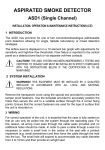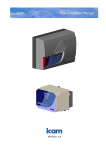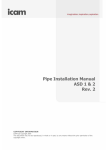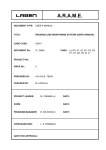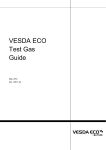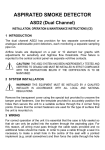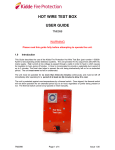Download Pipe Installation Manual Revision 2.2
Transcript
Pipe Installation Manual Revision 2.2 COPYRIGHT INFORMATION ICAM Ltd Copyright 2007 This document may not be reproduced, in whole or in part, by any means without the prior permission of the copyright owner. Pipe Installation Manual V2 Contents 1 2 INTRODUCTION .......................................................................................................3 AIR-SAMPLING.........................................................................................................4 2.1Uses of Air-sampling 4 2.1.1 2.1.2 2.1.3 2.1.4 2.1.5 3 Early Detection Easy access Protection of Voids, Limited Access and High Areas Flexibility Low profile installations 4 4 4 4 4 GENERAL DESIGN ....................................................................................................5 3.1System layout 5 3.2System block diagram 6 3.3Wide-bore Systems, Units & Accessories 7 3.3.1 3.3.2 3.3.3 3.3.4 3.3.5 3.3.6 3.3.7 3.3.8 Detector Units LASD 1 & 2 Detector Unit FireTracer PICO Detector Unit FireTracer FT1 – FT4 – FT6 Pipe Sections and Fittings Brackets Condensation Trap Heater Element with Condensation Trap Filter Elements 7 7 7 8 10 11 11 12 3.5.1 FireTracer 8 & 15 14 3.4PipeTracer Software 13 3.5Microbore systems 14 4 Detailed Design and Installation...............................................................................15 4.1The Design Process 15 4.1.1 4.1.2 4.1.3 4.1.4 4.1.5 4.1.6 4.1.7 Requirements Activities Physical Characteristics Environmental Conditions Risk Assessment Location PipeTracer 15 15 15 16 16 16 16 4.3.1 4.3.2 Response Times Dilution 17 19 4.6.1 4.6.2 4.6.3 4.6.4 General Still Air Design Inter-beam Sampling Capillary Sampling Localised Monitoring 4.7.1 4.7.2 4.7.3 4.7.4 4.7.5 4.7.6 4.7.7 4.7.8 Design for Rapid Air Movement Environments Simple Re-circulation Units AHUs with Low Level Return AHUs with High Level Return AHUs with Under Floor Return AHUs with Above Ceiling Return Design for Duct Sampling Systems Sub-floors and ceiling voids 4.2Typical layouts 17 4.3Response Times and Dilution 17 4.4Commissioning an installation 20 4.5Rules of thumb 21 4.6Design for Still Air Environments or Secondary Sampling Systems 22 4.7Design for layouts with Air Handling Units (AHU) or Primary Sampling Systems or Focussed Sampling Systems 27 Part No. 09-0003-2.0 LASD/FireTracer Pipe Installation Manual 1 Copyright C 2007 22 25 25 26 27 29 30 31 32 33 34 35 4.8Unusual Applications 36 4.8.1 4.8.2 4.8.3 4.8.4 4.8.5 4.8.6 4.8.7 4.8.8 4.8.9 4.8.10 4.8.11 4.8.12 4.8.13 4.8.14 High Areas Clean Rooms Freezer rooms Cold rooms Supermarkets and storage areas Warehouses Server Rooms Historic buildings Train compartments Prison cells and detention rooms Elevator machine rooms and shaft Stables & Live Stock Areas Wind generators What sampling method to use Part No. 09-0003-2.0 LASD/FireTracer Pipe Installation Manual 2 36 37 38 39 40 42 43 45 46 46 47 48 48 49 Copyright C 2007 1 INTRODUCTION This document is a guide for the installation of pipe-work for air-sampling or aspirating systems. The pipe network is as important as the detector itself and provides a means of obtaining a reliable and continuous sample of air to be monitored. The pipe work for air-sampling systems can vary greatly depending on the particular application. This manual, therefore, gives overall guidelines that can be applied to any system but also a number of specialised installations are described in more detail. These include: Clean rooms Cold stores Computer Centres Duct sampling High or large area buildings When designing a sampling pipe network one needs to achieve an air sampling network design that offers sampling hole (detector) area coverage that meets as a minimum the requirements for point type detectors. This guide is intended to give general guidelines for installing air-sampling systems but in each case, the local standards and codes of practice are to be taken into account. For reference, guidance on the design of systems is given in BS 5839, BS 6266 (Code of Practice for Fire protection for Electronic Data Processing installations) and in BFPSA COP. Other requirements can be company, industry or application specific like (e.g. document WNP/CPG 57200 from British Telecom). Aspiration system designers must be familiar with the local standards. It is strongly recommended that, before designing the pipe-work system, smoke tests be undertaken in order to show the patterns of air movement within the areas to be protected. This is particularly important in rooms with air-handling equipment. More details are given at relevant points throughout the text. Finished installations must be subjected to System Performance Tests. The various applicable tests can be found in the BFPSA Code of Practice for ASD’s. Part No. 09-0003-2.0 LASD/FireTracer Pipe Installation Manual 3 Copyright C 2007 2 AIR-SAMPLING ICAM offers wide bore air-sampling systems with laser detectors. The system has specific applications ranging from simple duct detection to monitoring sensitive installations such as clean rooms, computer centres, telecommunications rooms and many other areas. Air sampling is the technique where air is actively drawn through pipes from protected areas to a central unit, where the actual smoke detector is situated. This is in contrast with traditional point detectors, where the unit is actually in the protected area. In the LASD, the sampled air is monitored by sophisticated analysers for low levels of smoke. This enables early warning to be given well before the first flame is visible. 2.1 Uses of Air-sampling Air sampling offers many benefits: Very early detection due to high sensitivity for computer and server rooms. Easy access using pipe network, the detectors are at ground level. Protection of voids, inaccessible, high and hostile areas like atria, cable ducts, elevator shafts. Good flexibility due to being microprocessor controlled offering several sensitivity settings. Low profile installations using micro-bore pipes or capillary tube sampling within ceilings or below floors. 2.1.1 Early Detection Fires rarely break out in an instantaneous conflagration. Instead, the fire source may smoulder for minutes or hours before the flames appear. In this incipient or pre-fire stage, combustion products (mainly smoke) are generated but at levels which conventional point systems simply cannot detect. Laser based air sampling systems employ a much more sensitive detector than point systems (point systems typically detect between 2.0% and 4.0 % obscuration/meter). These sophisticated devices can pick up the traces of incipient fires (as low as 0.001% obscuration/meter) and raise an alarm. The incident can then be dealt with well before it becomes an actual fire. Desired sensitivity, pipe length, number of holes and transport time are to be calculated with the PipeTracer modelling software package. This package will also take in account the number of bends and the use of capillary tubes. 2.1.2 Easy access Only the control unit (placed at a convenient location) requires servicing. The alternative is servicing tens of point detectors, located in many different rooms. This system of using a pipe network with sampling points means that 2000 m2 can be covered with just one detector. The 2000 m2 is not the physical limit but recommended by local codes of practice. 2.1.3 Protection of Voids, Limited Access and High Areas Air samplers are ideal for such situations. Pipe work and associated sampling points are installed once and then require no further service. Save for testing from the sample point or inspection point. By contrast, point detectors [being located in the physical area of coverage], may be difficult or even impossible to test, service or update because of the location. 2.1.4 Flexibility LASD units are microprocessor controlled. The control systems are therefore programmable from the unit front panels. Alarm levels & sensitivities can be set individually for each pipe. 2.1.5 Low profile installations Often, in situations such as historical buildings, it is important to keep the installation from interfering with the décor or structure. The LASD can be used in conjunction with capillary tubes, which are, not only small in diameter, but are also extremely flexible. This enables pipe runs to be hidden in coving or a similarly unobtrusive place. The majority of the pipes is above the ceiling or beneath the floor and only the end of the capillary tube is visible. Part No. 09-0003-2.0 LASD/FireTracer Pipe Installation Manual 4 Copyright C 2007 3 GENERAL DESIGN 3.1 System layout The majority of aspirated smoke detection systems are used in one of two ways. The first is when there is an air handling system in the area to be protected. The second is when sampling points are used where one would normally use standard detectors, mainly in still air environments. There are also specific layouts and applications, some of which will be covered later although it is always necessary to look closely at any installation because almost every location is different. A typical system layout is shown below. This is the most basic of wide-bore set-ups. Mounting brackets Pipe(s) with sampling holes End cap with hole LASD detector Note: a smoke test conducted prior to installation will give you a good indication of how some will travel within the area to be covered. Part No. 09-0003-2.0 LASD/FireTracer Pipe Installation Manual 5 Copyright C 2007 3.2 System block diagram Capillary sampling points Air intake Air sampling points Hole diameter and location along the pipes through PipeTracer software package End cap Air flow sensors monitor blockages and fractures of the individual pipes (*) In-line filter Aspirated Smoke Detector Heater & water trap (*) A single hole blockage is not an appropriate test for flow fault control. As per BFPSA COP, a 20% reduction in volumetric flow (EN54-20) is considered an appropriate fault condition. It is generally the case that sampling holes do not block individually but all become contaminated at similar rates. In this case, regular maintenance, including inspection/cleaning of sampling holes and monitoring for changes in pipe flow rate between visits is sufficient to ensure the integrity of the ASD system. Part No. 09-0003-2.0 LASD/FireTracer Pipe Installation Manual 6 Copyright C 2007 3.3 Wide-bore Systems, Units & Accessories LASD (Laser Aspirated Smoke Detector) air-sampling systems have one to six wide-bore rigid pipe inlets. It is recommended that ABS pipe is used due to its strength and heat resistant properties. These pipes can be hung under or in the ceiling of the area to be protected, in voids, shafts etc. Air is drawn in from the protected area, through a number of small holes in the sidewall of the pipes. The red pipes carrying the warning ‘ASPIRATING SMOKE DETECTION SYSTEM – DO NOT PAINT OR OBSTRUCT INLETS’ are preferred. It may in certain cases be favoured to use standard plastic conduit to avoid attention and tampering. At all times make sure the installation conforms to local regulations and is approved by local authorities. . NOTE: Pipes should be glued together to avoid separation or leaks but the pipes must not be glued into the unit itself. Removable unions should be used where maintenance may require pipes to be taken apart or removed. 3.3.1 Detector Units LASD 1 & 2 One and 2 pipe units with laser point detectors 3.3.2 Detector Unit FireTracer PICO One pipe unit with very high sensitivity laser detector 3.3.3 Detector Unit FireTracer FT1 – FT4 – FT6 One, four and six pipe units with very high sensitivity laser detector Part No. 09-0003-2.0 LASD/FireTracer Pipe Installation Manual 7 Copyright C 2007 3.3.4 Pipe Sections and Fittings Straight pipe sections Pipes are made of ABS and come in lengths of 3 meter. Straight union Connects the pipes together. Make sure pipes and unions are always glued together. T-union Allows to T-off to one or two sections of pipes. Removable Union Use when a connection is not to be permanent. I.e. when section of pipe needs to removed for maintenance of equipment like with Air Handling Units Sticker to identify the sampling hole Part No. 09-0003-2.0 LASD/FireTracer Pipe Installation Manual 8 Copyright C 2007 End caps, (typically with a 6mm hole) Used at the end of a pipe run. Diameter of the hole determines airflow and is determined in the PipeTracer program. Bends (45º and 90º Always use slow bends to minimise pressure loss in the system. Capillary tubes and sampling points Capillary tubes and associated sampling points allow sampling at a specific location away from the pipes. Used with i.e. with false ceilings, cabinets etc. Gluing process Make sure pipe is cut square and cleaned with appropriate solvent cleaner. Use adhesive sparingly but ensure that it has been applied over the entire area to be bonded. Part No. 09-0003-2.0 LASD/FireTracer Pipe Installation Manual 9 Copyright C 2007 3.3.5 Brackets Channel Bracket Used to click on a channel. Studding Bracket Used to mount on a treaded rod. Wall Bracket Used to be fixed directly to a wall or ceiling. Closed Pipe Clip Used to be fixed directly to a wall or ceiling. Open Pipe Clip Used to be fixed directly to a wall or ceiling. Part No. 09-0003-2.0 LASD/FireTracer Pipe Installation Manual 10 Copyright C 2007 3.3.6 Condensation Trap If the air being sampled is hot and humid and there is the possibility of a temperature change causing condensation to form in the sampling pipe, a condensation trap can be used to avoid the moisture reaching the detector. As shown in the picture below, a micro-bore pipe is connected to an end cap which forms the trap. The moisture will collect in the pipe but run down and eventually out of the system prior to entering the detector. Make sure the pipe(s) are angled down towards the water trap and then onto a local drain, or water tight container that should be changed regularly. Condensation traps must be primed (filled with water) when installed or air will be drawn through the trap. . 3.3.7 Heater Element with Condensation Trap When cold air is returned as in cold stores it is important to provide heating elements (30 W-230Vac) to avoid icing of the units (see section freezers for more details). Heaters always need to be used in conjunction with water traps. Make sure the pipe(s) are angled down towards the water trap and then onto a local drain, or water tight container that should be changed regularly. Condensation traps must be primed (filled with water) when installed or air will be drawn through the trap. Part No. 09-0003-2.0 LASD/FireTracer Pipe Installation Manual 11 Copyright C 2007 3.3.8 Filter Elements Wide bore filter The Filter, 02-FLU1, is used as a pre-filter where aspirating systems are installed to monitor excessively dusty or damp environments. Aspirating systems are ideally suited to harsh environments where conventional smoke detectors would fail to operate when subjected to water spray or excessive dust. The tubing network can be kept clean with periodic manual or automatic compressed air purges and the air sampling detector can be protected with filter+. The filter element has a large surface area to minimise the service replacement intervals. The particle sizes trapped by the element are 30 m and above as standard with other pore sizes available. Smoke particles, having a typical size of 0.01-2.5 µm, will pass through the dust filter and be detected by the laser detector. End of line sintered filter for Capillary tubes It is recommended that a sintered end of line filter is used at the end of every capillary tube. This will ensure that the airflow is not impeded by blockages such as insects nesting within the capillary tube. A sampling point like the one below can also be used to provide both a sturdy and safe end point and also an aesthetically pleasing one. This sampling point can be screwed to walls or ceilings. The small maze grid acts as a filter. Part No. 09-0003-2.0 LASD/FireTracer Pipe Installation Manual 12 Copyright C 2007 3.4 PipeTracer Software PipeTracer is a pipe work modelling and flow calculation software for wide-bore systems. Once you have modelled your pipe network PipeTracer can predict such quantities as: Flow times (smoke travel time) Flow volumes Pressure drops Sensitivity This package has been designed to be simple to use. For example, a set-up wizard simplifies the creation of your pipe network, while a multi level undo/redo facility is available in the editing stage, should the initial design require altering. Either metric or imperial units may be selected for editing and display. A key requirement of such software is the need to calculate air flows through the pipe network. Advanced numerical optimisation techniques ensure that this process is very fast. All calculations are based upon full fluid dynamics theory and so take account of laminar and turbulent flow regimes within the system. PipeTracer software also allows the sampling pipe network and system sensitivity to be designed and adjusted to achieve one of three levels of sensitivity. The different sensitivity classes are a requirement of EN54-20 and are referred to in the BFPSA COP. - Class C: Normal Sensitivity - the same sensitivity as normal point optical detectors, typically over 2 % obscuration/ metre. - Class B: Enhanced Sensitivity - responding to smoke concentrations of between 0.8% and 2% obscuration/metre. - Class A: High Sensitivity - responding to smoke concentrations less than 0.8% obscuration/metre. The obscuration values refer to the sensitivity at each sampling hole and not the claimed sensitivity of the detector. Part No. 09-0003-2.0 LASD/FireTracer Pipe Installation Manual 13 Copyright C 2007 3.5 Microbore systems 3.5.1 FireTracer 8 & 15 FireTracer 8 and 15 have 8 and 15 micro-bore pipes respectively. The 6 mm O.D, 4 mm I.D. pipe is flexible, and therefore easy to install. It is vital that the pipes are of a similar length. If this is not the case, performance may be severely affected. In contrast with the wide-bore systems, air is only drawn in through the end of the pipe. When smoke is detected, the system will scan the pipes until the source is found. Such systems are particularly suited to cabinet protection, where a pipe may be placed directly in each cabinet. This offers pinpoint location, combined with the earliest possible detection. In this example the flexible pipes are laid in the floor void, and brought up to the top of each cabinet. The smoke is not diluted by being mixed with the general air in the room, nor is it dependent upon the vagaries of air currents. Since each cabinet has an individual pipe, if an alarm occurs, the source can be traced to a single cabinet, rather than the whole room. This minimises time taken to find the source. It is recommended that a sintered end of line filter be used at the end of every pipe. This will ensure that the airflow is not impeded by blockages such as insects. A sampling point like the one below can also be used to provide both a sturdy and safe end point and also an aesthetically pleasing one. These can be screwed to walls or ceilings and also incorporate filters. Part No. 09-0003-2.0 LASD/FireTracer Pipe Installation Manual 14 Copyright C 2007 4 Detailed Design and Installation 4.1 The Design Process When designing the actual sampling pipe network there are many factors that need to be considered. The site must be carefully surveyed and as much information as possible should be gathered. The ASD Planning and Overview Form and the ASD Design Form from the BFPSA COP come in handy at this stage. 4.1.1 Requirements It is critical to define requirements and expectations at an early stage. Consider carefully the following points: What are the end users expectations? What are the risks? What sensitivity is required from the system? What area is to be covered? What response times are required? Without concrete answers to the above there is the hazard of a badly performing system and an unsatisfied customer! Once these have been decided, the type of situation can be looked at. 4.1.2 Activities The types of activities that take place within the space are very important. A public area of a particular shape could well have different system requirements to a warehouse of a similar shape. Some different examples are outlined below. Historic buildings Chill and Cold stores Microelectronics clean rooms EDP (Electronic Data Processing) rooms, offices, communications switch rooms Shops, theatres, leisure centres, churches, libraries Hotels, hospitals, prisons Factories, warehouses Other information such as the expected hours of operation, whether the area is manned or unmanned and whether any pollution or dirty air is present should also be taken into account. 4.1.3 Physical Characteristics Once the general installation type has been considered, the physical characteristics of the space are looked at and the following questions should be asked. Is it a room, void, cabinet or enclosure? Are there any floor or ceiling voids and, if so, how are they divided, are there any ducts, what are these used for and are there any services already present? What are the exact measurements of the space? What materials have been used and are there any areas where the network has to avoid? Are there any existing fire protection systems and where are they situated? Does the fire load change regularly? Part No. 09-0003-2.0 LASD/FireTracer Pipe Installation Manual 15 Copyright C 2007 4.1.4 Environmental Conditions The environment within the space can have a very significant bearing on which sampling method should be used to protect it. As already mentioned, the smoke tests are vital in gathering this information. This can tell you the patterns of air movement, the rate of circulation and whether the airflow is static at any point. Other considerations include: If fresh air is introduced, at what rate and in what quantity? What is the temperature and relative humidity and are these constant or variable? Are there any activities that may produce smoke, dust, steam or flames and how often does this occur? 4.1.5 Risk Assessment With any installation it is likely that some areas require more protection than others. This could be because of expensive equipment or a particularly vulnerable area such as a store for flammable materials. These more susceptible areas must be considered along with any structural hazards such as synthetic materials and foams or soft wood partitioning. 4.1.6 Location There are also factors to consider when deciding on the position at which the detector itself will be situated. The main aim when positioning the detector unit is to try to ensure a balanced system. This means that the pipes should be kept at similar lengths. It is also important to try and keep response times and dilution to a minimum. These are two very important factors in air-sampling and are discussed in more detail in the following section. The unit requires a power supply and access will be required for maintenance. There may also be aesthetic reasons why a particular position is not suitable. 4.1.7 PipeTracer Once the network has been designed, PipeTracer can be used to calculate the sensitivity, response times, flow volumes and pressure drops. This shows whether the network will perform as expected and if any further design is required in order to achieve the desired performance from the system. Part No. 09-0003-2.0 LASD/FireTracer Pipe Installation Manual 16 Copyright C 2007 4.2 Typical layouts The drawings use LASD systems as example but apply to all wide bore systems. Dimension A should not exceed 1 m. Type 1 layout both pipe runs can go up to 100 m (B). For detailed planning, check application with PipeTracer. Type 2 layout, T-pipe, both pipe runs each side of the T junction can go up to 100 m (A+B). For detailed planning, check application with PipeTracer. B A 4.3 Response Times and Dilution Dilution and response times are two factors that can cause the system to under-perform. 4.3.1 Response Times The transport time of a system is the time taken for a smoke particle to travel from the sampling point to the detector. The response time is the transport time plus any delays set in the detector. In any situation where an airsampling system is being used, early detection is vital and therefore response times are kept to a minimum. The simplest method of achieving this is to keep pipe lengths to a minimum. This is not always possible but in this example the benefits of using more than one pipe in short lengths is demonstrated. Example: The advantage of multiple sampling pipes. This room has a single sampling pipe that provides detection for the whole room. Part No. 09-0003-2.0 LASD/FireTracer Pipe Installation Manual 17 Copyright C 2007 In the above picture, the single pipe runs for approximately 100 meters. If the data is entered into the PipeTracer software, a response time of 28 seconds is given. Apart from the length of pipe and the distances between bends, all other variables were left at the default values for the purposes of this example. This includes the heights of the room and system and the frequency and size of the sampling holes. The room with two sampling pipes: With two pipes, the response time is reduced to 8 seconds. Each pipe is 50 meters long but the system gives the same coverage as it would with one pipe. The room with four pipes: With four pipes the response time is now reduced to 2 seconds. The system is well balanced and therefore the response time for each pipe is the same. The sampling holes in the system are at 5 meter intervals giving a general overall coverage of the room. Part No. 09-0003-2.0 LASD/FireTracer Pipe Installation Manual 18 Copyright C 2007 4.3.2 Dilution As the name suggests, dilution is the process of lessening the concentration of smoke particles as the sample is sucked towards the detector. For example, with wide-bore pipes: There is a sampling pipe measuring 100 meters. It has sampling holes every 5 meters, giving 20 sampling holes including the end cap. It can be assumed in this simplified case that the sampling holes let in approximately the same amount of air as each other. A smoke source of 2% obscuration/meter is introduced at the far end of the pipe. No other smoke is entering any of the other sampling holes. As the smoke passes each hole, it is added to with clean air. When the sample reaches the detector it is now at 0.1% obscuration/meter or 1/20th of its starting density. Therefore if the first alarm threshold is set at 0.1% obsc/m, the smoke outside the hole must exceed 2% obsc/m to sound the alarm. It is the case, therefore, that the longer the pipe and the greater the number of sampling holes, the more susceptible the system will be to dilution. It is wise to work on a worst case principle in these situations. Actuality the calculation of dilution is not as straightforward as above and more factors are involved. Each system will have different characteristics meaning precise calculation is extremely complicated. Lower density to detector Smoke in high density Clean Air With micro-bore systems there are no side sampling holes to let in clean air. The dilution occurs at the detector when the pipes come together. If an FT15 is being used with all of its fifteen pipes sampling then each pipe brings in 1/15th of the sampled air (assuming a balanced system). The number of pipes is directly related to the fraction of the total air that is sampled making calculations more straightforward than with wide-bore systems. Part No. 09-0003-2.0 LASD/FireTracer Pipe Installation Manual 19 Copyright C 2007 4.4 Commissioning an installation It is necessary to carry out an inspection of the completed installation to check for quality of workmanship, correct use of materials and that the installation fully complies with the correct National Standard that the intended ASD systems have been installed to. After the wide bore pipe network has been installed, before the end cap is put on and before the pipes are attached to the unit it is necessary to clean the internal pipe system to remove unwanted swarf debris and dust which could affect the ASD system performance. This may be done by either a positive blowing-out of the pipe network with compressed air or by the use of a vacuum cleaner. Commissioning tests should be carried out depending on the ASD system application and only when the building is in its normal, intended running state. Appropriate commissioning tests should also be performed after modifications and/or additions to the ASD system. BFPSA COP presents a matrix of performance tests according to the desired response of the system (Class A, Class B or Class C) and the type of application. Always provide for an easy access test hole at the furthest end of all pipe runs! Easy access test point Part No. 09-0003-2.0 LASD/FireTracer Pipe Installation Manual 20 Copyright C 2007 4.5 Rules of thumb When designing aspiration systems it is good workmanship to observe the rules of thumb listed below • • • • • • • • • • Sensitivity of sampling point is larger or equal to normal sensitivity point detector, depending on sensitivity setting of the detector. Better than 50% Balance. 90 or 120 Second maximum response time. 30 micron size particle size not to affect operation. Spacing requirements not to exceed point detector spacing. Joints shall be permanently bonded. If the sensor is mounted outside the protected area, return the exhaust back to the protected area. Do not run pipes in areas with different air pressure ABS or PVC Pipe to comply with local quality standards. Power supply to comply with local requirements When using Multiple Pipe Systems • • • • • • • • Length of pipe: shorter pipe length shorter response times. Share per hole: shorter pipes = better hole share, i.e. the difference between the flows into the first and last sampling points are reduced as the pipe gets shorter. Use the end cap venting to provide a minimum hole share of 70%. Number of Bends: less bends less travel time and better flow. System Balance: multiple pipes provide better balance. Size of the End Cap: smaller end caps provide better hole share and system balance, i.e. the difference between the flows into the first and last sampling points are reduced as the hole in the end cap gets smaller. The flow through the penultimate hole must be at least 70% of the best sample point flow. Do not run pipes in areas with different air pressure In general PipeTracer is the tool to be used to model the pipe lengths, holes, fan speeds and end caps. Only smoke tests will show exact smoke path, helping the designer to correctly locate pipes and sampling holes Part No. 09-0003-2.0 LASD/FireTracer Pipe Installation Manual 21 Copyright C 2007 4.6 Design for Still Air Environments or Secondary Sampling Systems 4.6.1 General Still Air Design Still air environments, such as warehouses or store rooms, do not have a pattern for the air movement. This means that the sampling points must give general cover across the whole expanse of the area. Each system can cover a total area of 2000m2 but careful consideration must be given to the layout in order to design a balanced network that will perform as required. The coverage and layout will closely follow the guidelines for traditional point detectors. Failure to design and install a properly thought out pipe network can result in slow response times thereby negating some of the early warning ability of the system. The way to avoid any problems occurring is to ensure that all pipes are of similar, or preferably equal, length. Typical examples: Warehouses, store rooms, cold stores, historic buildings, places of worship, office buildings and residences. Design Criterion: Design to BS EN 54 (BS 5839 Pt.1) that states that no point in the room should be further away from a detector than 7.5 meters. Each traditional detector should cover an area no greater than 100 square meters. Each system should not cover more than 2,000 square meters. Keep the pipe lengths as similar as possible to ensure a balanced system and minimal response times. Distance A: maximum 5 m Distance B: maximum 10 m Part No. 09-0003-2.0 LASD/FireTracer Pipe Installation Manual 22 Copyright C 2007 This layout is showing point detectors in a simple 2000 square meter building This layout is showing a sampling system in a simple 2000 square meter building. The four pipes cover the same area. The red dots show the position of the sampling holes which are identical to the position of the point detectors above. The sampling pipes must be fixed in such way that the sampling holes are 2.5 to 6 cm below the ceiling and facing down. Similar to point detectors the sampling hole must be below the hot air layer that prevent smoke raising to the ceiling. The width of the pipes and the detector in the picture are enlarged in order to make them clearly visible. Part No. 09-0003-2.0 LASD/FireTracer Pipe Installation Manual 23 Copyright C 2007 Always use a grid overlay to determine the correct positioning of the pipe network and ensuring full area covering. X Incorrect positioning as not all of the area is covered Correct positioning as all of the area is covered. Total area is green. Part No. 09-0003-2.0 LASD/FireTracer Pipe Installation Manual 24 Copyright C 2007 4.6.2 Inter-beam Sampling Pipe routing is subjected to the same rules as point detectors with respect of beams. Please consult local regulations for the definitions of ‘flat’ surfaces and beam depth to determine number of sampling holes and pipe runs. 4.6.3 Capillary Sampling Short lengths of small diameter flexible pipe may be spurred off from the main wide-bore pipe. These capillaries should have an internal diameter of no less than 7mm and can be up to 1,5 meters length. To create the sampling point, a sampling point assembly should be used. Capillary Sampling is particularly useful for concealed sampling points For aesthetic reasons, the sampling points may need to be as unobtrusive as possible. Often the main wide-bore pipe runs through a ceiling void, with capillary sample pipes taken off through the ceiling. The sampling holes are made using a sampling point assembly. This is a simple assembly into which the capillary tube fits. If small insects or dirt is expected a sintered end of line filter can be mounted to the sampling point itself. Capillary tubes Ceiling panel or tile Concealed Sampling point fitting Part No. 09-0003-2.0 Sampling point fitting LASD/FireTracer Pipe Installation Manual 25 Copyright C 2007 4.6.4 Localised Monitoring Capillary pipes can be run into individual cabinets or places but often it is preferable to monitor each cabinet separately. With the icam micro-bore systems this is easily achieved. The FT 8/15 has eight/fifteen individual micro-bore tubes enabling the simultaneous monitoring of fifteen different places. These could all be server cabinets or each tube can monitor a completely unrelated situation. In the picture below, a single FireTracer is monitoring: three server cabinets two points in an air handling unit the outside air as a reference line the hydrogen levels in a UPS room (using a gas sensor) This still leaves lines free which could be used in areas such as open frame racking or more server cabinets. Due to the nature of the system, there is no dilution along the pipe and it is not affected by air currents. The pinpoint detection offered by this system further increases the benefits of early warning systems by allowing the user to track down the exact location of the fault immediately when it is first detected. The balance of the pipes is very important. If all the pipes are not of a similar length, performance may be severely affected. The longer pipes in an unbalanced system will not perform as well as the shorter ones. If all the pipes are the same length this problem is easily avoided. One way of achieving this is to coil the excess flexible tubing if a shorter length is required (this is not shown in the pictures). As compromise the microbore can have a T-off at the end in to two short runs of 1 meter maximum. Ensure there are no kinks in any part of the system. Maximum pipe length 50 m. Part No. 09-0003-2.0 LASD/FireTracer Pipe Installation Manual 26 Copyright C 2007 4.7 Design for layouts with Air Handling Units (AHU) or Primary Sampling Systems or Focussed Sampling Systems 4.7.1 Design for Rapid Air Movement Environments In any situation where air handling units are involved, the nature of these has to be taken into account. The majority will require the sampling holes to be drilled directly in the air flow at the return grill or duct. This is the point at which any smoke will definitely pass through while the AHU is operating. If the AHU does not operate permanently, either due to power failure, maintenance or as a standard setting, the directions for still air environments must be taken into account. If this is the case then a secondary element must be built into the system to ensure complete twenty-four hour coverage. Also take in account under floor and above ceiling areas! In all cases the aim must be to place the sampling pipes at the position the smoke is most likely to reach. This should be established by performing extensive smoke tests, making sure the smoke is clearly visible. A: Path of still air B: Path of ventilated air Part No. 09-0003-2.0 LASD/FireTracer Pipe Installation Manual 27 Copyright C 2007 Typical examples: Computer rooms, data storage rooms, server rooms, archives, control rooms and environmental test chambers. Design to BS EN 6266-2002 for EDP Areas. The standard recommends that a single detector covers an area of 25-30 sq. meters. Distance A: maximum 2,5 m Distance B: maximum 5 m NFPA 72 supplies information on area coverage vs. air change rate Air Changes/Hr 60 Square meter coverage 12 30 20 15 23 35 46 12 58 10 70 8.6 81 7.5 84 6.7 84 6 84 With sampling system installations it is very unlikely that there will be two that are identical to each other. The following examples of various installations are, therefore, guidelines which are designed to show the principles behind designing such a system. In order not to detract from the design basics, the illustrations have been kept simple by not showing brackets and holes where they would clutter the picture although it must not be assumed that these are unnecessary. The categories of air handling unit that are looked at are: Simple re-circulation Low level return High level return Under floor return Because of dilution by the rapid air movement, no more than 3 air-handlers should be covered by one air-sampling system. It is recommended that each sample point shall have a maximum area coverage of 0.4m2 of the air grille. Typically 3 or more sampling holes are to be used to cover a single air intake. The velocity of the airflow into the grille is typically 4-6m/s. Where larger airflows are encountered special arrangements may be necessary such as positioning the pipe away from the grille using stand-off bracket. I doubt contact your nearest distributor or ICAM. Part No. 09-0003-2.0 LASD/FireTracer Pipe Installation Manual 28 Copyright C 2007 4.7.2 Simple Re-circulation Units The most basic type of air-handling unit is a simple re-circulation system. The unit moves air around the room rather than drawing fresh air into the system. In this case either the exhaust or the return grille may be covered. An example of a ceiling mounted re-circulation unit is shown below. Here, as established by a smoke test, the air is blown out of the sides of the ceiling mounted air-conditioning unit and drawn back in to the centre of the unit. The arrows show the direction of the air flow. The pipe-work is suspended underneath the return grill with the sampling holes facing into the air flow. It is crucial that your pipe-work does not prevent access to the air-handling unit. Therefore use removable unions, rather than solvent welded sockets in places where you will need to move pipe-work for access to other equipment for maintenance (e.g. replacing filters). Holes along the pipe should be at approximately 200-300 mm distance from another. ALWAYS RECONNECT PIPEWORK AFTER INSPECTION. Part No. 09-0003-2.0 LASD/FireTracer Pipe Installation Manual 29 Copyright C 2007 4.7.3 AHUs with Low Level Return A typical AHU with low level return is shown below: The pipes have sampling holes situated in front of the grills, facing into the airflow to maximise the sample. Smoke tests will show where te best locations are, e.g. in the middle of the grill or at the edge of the grill. The airflow is indicated by the arrows. Air is sucked in through the grill and pumped back out of vents in the ceiling. Ideally, the pipes between the AHUs would run under the floor or within the wall but are shown here, and throughout the examples, for demonstration purposes. Unions are used on either side of the grill to enable maintenance to take place. Holes should be at approximately 200-300 mm distance from another. Part No. 09-0003-2.0 LASD/FireTracer Pipe Installation Manual 30 Copyright C 2007 4.7.4 AHUs with High Level Return A typical AHU with high level return is shown below: The pipes have sampling holes above at the edge of the grills. These are at an angle of 45°, facing into the airflow. The airflow is indicated by the arrows. The air is re-circulated and comes out of vents on the other side of the room. Smoke tests will show where the best locations are. Holes should be at approximately 200-300 mm distance from another. Sampling point angled to obtain best air sample Stand-off post -distance dependent on smoke test AH AHU vent Part No. 09-0003-2.0 LASD/FireTracer Pipe Installation Manual 31 Copyright C 2007 4.7.5 AHUs with Under Floor Return An AHU with under-floor return is shown below: A pipe is used to ensure that the area of the grill is properly covered. The air is drawn up through the floor; therefore the pipe is suspended beneath the air intake. Holes should be at approximately 200-300 mm distance from another. Part No. 09-0003-2.0 LASD/FireTracer Pipe Installation Manual 32 Copyright C 2007 4.7.6 AHUs with Above Ceiling Return Two pipes are used to ensure that the area of the various grills are properly covered. The air is drawn up through the ceiling, therefore the pipes are suspended above and in front of the air intakes. Holes should be at approximately 200-300 mm distance from another. Part No. 09-0003-2.0 LASD/FireTracer Pipe Installation Manual 33 Copyright C 2007 4.7.7 Design for Duct Sampling Systems Return Air, Exhaust Air and other Air Conditioning Ducts are typically regions of very high airflow. Providing Aspirated Air Sampling Detection Systems in these areas can be very beneficial. Large areas can be protected with relatively few detectors and also with minimal intrusion into the protected area thereby reducing the costs of installation and maintenance involved. This method is also unobtrusive which can be an important factor in deciding the type of installation for architects and end users. Normally Aspirated Air Sampling Systems would be placed in air return ducts as supply air ducts can be filtered or be contaminated with makeup air possibly making the system ineffectual and the cause of nuisance alarms. If the ventilation system does not operate permanently it may be necessary to install a secondary system to sample within the protected area during the times that the Air Conditioning plant is shut down. In some countries this is mandatory. The intake pipe should span approximately the entire duct width. If the duct is very wide then, to increase rigidity, the pipe may be supported at intervals across the duct. For small ducts up to 1m across sampling holes at 100 to 150mm intervals. For larger ducts sampling at intervals of 200 – 250mm is appropriate, It ,may also be necessary to run the sampling pipe at more than 1 level through the duct especially when the sampling is located close to bends in the ductwork The holes should face 20 to 45 degrees above or below the centre line of the airflow stream to so at avoid the pressure curve that forms around the pipe as the airflow passes around it. The first and last hole are normally located about 100 mm from the edges of the duct to be into the laminar flow area of the duct. Exhaust holes opposite of the inlet holes must be facing down wind. It is recommended that each sample point shall have a maximum area coverage of 0.4m2 of the cross sectional area. Also have the same number of holes on the inlet pipe AND the outlet pipe. Doing so, if the airflow changes in the duct, the pressure across the detector can be maintained and therefore a flow fault will not occur. Flow faults will only annunciate when the flow through the detector fails, i.e. failed air pump or blocked holes. The end of the pipes should be extended through the side of the duct and have end caps fitted. The holes through which the pipes are positioned must be kept airtight. The intake should be offset from the exhaust pipe to avoid turbulence, with at least 300mm (distance A) separating the two as well as being at least 50mm different in height (distance B). The material of the sampling pipes should be suitable for the application i.e. verify if the duct is carrying extremely hot air or gasses that are not suitable for the standard plastic in which case copper of steel conduit may be used. Ensure that an extended pipe run is made outside the duct to allow the sampled air to cool. If the air inside the duct is hot and/or humid, problems will occur if the temperature changes and cause condensation within the cooler sampling pipe outside the ductwork. If this is the case, use a condensation trap before the sampling pipe enters the detector to stop the ingress of moisture into the detector. Ensure that the intake pipe is dropped lower than the detector to house the water trap. This further ensures that overflow moisture cannot enter the detector. Pressure curve Part No. 09-0003-2.0 LASD/FireTracer Pipe Installation Manual 34 Copyright C 2007 4.7.8 Sub-floors and ceiling voids In some cases it is advisable to monitor a sub floor area or ceiling void, even if it is not part of the main airconditioning system. A typical example will be if they contain power or data cables as shown in the picture below. Pipe work to BS6266-2002 for primary detection Preferred sub-floor fixing of pipes Part No. 09-0003-2.0 LASD/FireTracer Pipe Installation Manual 35 Copyright C 2007 4.8 Unusual Applications Due to the fact that most installations take place in different environments, the guidelines above are fairly flexible. The exceptions come when exceptional environments are involved. If the area is essentially a room, with or without AHUs, then the rules are straightforward and vary little from place to place. Unusual applications are those which deviate in some way that changes the way the air movements may behave. These include high areas, voids, restricted areas or those which have safety considerations and places where samples may be contaminated with dust. In these different and variable situations, it is vital to perform smoke tests to establish the air movements. 4.8.1 High Areas Typical examples: Atria, Cathedrals. When designing a system to fit in a very large and high room such as an atrium or high level warehouse, it is very important to consider the various possibilities. A simple atrium design is shown below, utilising two vertical pipes. The smoke cloud is shown as an example of how a stratification layer prevents the pipes at the top of the building being effective. The height at which the smoke forms a layer varies depending on temperature and therefore a vertical sampling pipe is used to cover this. There may be no stratification layer at all if the air in the room is at a particular temperature. Smoke stratification layer at thermal equilibrium Part No. 09-0003-2.0 Laser detector Sampling pipes LASD/FireTracer Pipe Installation Manual 36 Copyright C 2007 l 4.8.2 Clean Rooms Very sensitive fire protection is normally required in clean rooms due to the type of work that is performed in them. Air handling units are necessary to enable the air to be changed and filtered. This means that the basic rules for rooms with AHUs are applicable. In general, and particularly with ULPA(1) and HEPA(2) filters, the sampling should take place in front or within the extract ducts, before the air reaches any kind of filter. The sampling pipe should cover as much of the grill as possible to maximise the likelihood of detection. It is recommended that pipe lengths are kept to a minimum to reduce response times as much as possible. (1) ULPA (Ultra-Low Penetration Air). Filters rated 99.999% efficient with particles 0.12 microns (µm) in diameter HEPA (High Efficiency Particulate Air [filter]) This type of air filter can remove at least 99.97% of airborne particles 0.3 microns (µm) in diameter. (2) UPLA / HEPA Filter Ceiling void Fresh air intake Clean room Floor void AHU Sub-Fab area Part No. 09-0003-2.0 Dry coil unit LASD/FireTracer Pipe Installation Manual 37 Copyright C 2007 4.8.3 Freezer rooms Freezer rooms often introduce extra difficulties into the design of a system. The temperatures at which the room operates must be taken into account. If the pipe network is inside the cold store the following few points should be noted. o o o o The pipes themselves should be suspended (or attached) further away than usual from the ceiling or wall as these may vary from the air temperature. Sampling holes should be drilled on the side of the pipes to minimise the risk of blockage due to ice formation. Vertical pipes running into the room from outside and areas where condensation could collect must be avoided. Sample points should not be positioned near to doors. When doors are opened, humidity in the warm air entering the freezer freezes. Heating elements are to be placed exactly where the pipe(s) come out of the freezer room Stand-offs to be minimum 30 cm from ceiling and walls Pipes to fall towards heater element Isolate sensor from wall Heater element Seal around pipes where coming out of freezer Return exhaust back to freezer area Water trap Part No. 09-0003-2.0 LASD/FireTracer Pipe Installation Manual 38 Copyright C 2007 Temperature changes may cause expansion or contraction in the pipe. ABS pipe has a linear coefficient of expansion of 10.1 x 10-5 /°C/m. If this is multiplied by the length or pipe and the temperature change then a figure for the expansion or contraction is given. These large changes normally happen as the system is installed at ‘room’ temperature and is run at operational temperature. So the changes can easily vary from +18°C to 35°C, representing a 53°C differential. This drop applied to a 50m pipe gives a required movement space of over 26 cm. If the nature of the system gives no allowance for variation in the pipe length, it is advisable to incorporate a simple U-bend to act as an expansion/contraction loop as shown below Stand-offs to be minimum 30 cm from ceiling and walls 4.8.4 Cold rooms Cold rooms or stores are similar to the freezer rooms with one major difference, the temperature. The temperature in a cold room is a lot less than in a freezer and is typically just above 0°C. typically 0-5°C. The pipes should be kept out of the immediate airflow of air blowing chiller unit when used as this air is often significantly colder than the room itself to maintain the correct temperature. In cold room applications one does not need to use a heater element but only a water trap to get rid of condensation. Chiller unit Correct pipe positioning Part No. 09-0003-2.0 LASD/FireTracer Pipe Installation Manual 39 Copyright C 2007 4.8.5 Supermarkets and storage areas Supermarkets and storage areas require a high level of protection due to the number of people using the space at certain times of the day and/or due to the value of goods present. The picture below assumes a simple room layout but in reality there are likely to be large air conditioning systems. In the latter case the guidelines for areas with air handling units (AHU) then apply. There are two ways of applying the pipe network. The structure of the roof is likely to determine the better or most appropriate solution. In Type 1 the pipes will follow the contour of the roof and be placed at maximum distance 10 m from each other. Sampling holes at maximum 10m from each other. Top hole at maximum 60 cm from roof top. Part No. 09-0003-2.0 LASD/FireTracer Pipe Installation Manual 40 Copyright C 2007 In Type 2 the pipes will run parallel along the room at maximum distance of 10 m. The top pipes should not be closer than 60 cm to the top of the roof as hot air will prevent smoke from getting there. Sampling holes at maximum 10 m from each other. Part No. 09-0003-2.0 LASD/FireTracer Pipe Installation Manual 41 Copyright C 2007 4.8.6 Warehouses Warehouses can be considered to be similar to supermarkets except the same problems that can occur with high buildings need to be taken into account. Vertical sampling points may be needed and the pipe lengths should be monitored to ensure reasonable response times. Part No. 09-0003-2.0 LASD/FireTracer Pipe Installation Manual 42 Copyright C 2007 4.8.7 Server Rooms Better than running a simple pipe above the cabinets is using capillary assemblies. Short lengths of small diameter flexible pipe may be spurred off from the main wide-bore pipe. These capillaries can be up to 1,5 meters length. To create the sampling point, a sampling point assembly should be used. Often the main wide-bore pipe runs through a ceiling void, with capillary sample pipes taken off through the ceiling. The sampling holes are made using a sampling point assembly. Part No. 09-0003-2.0 LASD/FireTracer Pipe Installation Manual 43 Copyright C 2007 The FT-series micro-bore systems are recommended for use with applications such as server and EDP rooms. The benefit of having individual cabinet monitoring is very important for achieving maximum protection. As with most installations, aesthetically, it is good practice to run the pipes through roof or floor spaces as has been mentioned earlier. Here, the number of parallel pipes makes this especially desirable. The direction of airflow trough the cabinets will determine top or bottom sampling. Part No. 09-0003-2.0 LASD/FireTracer Pipe Installation Manual 44 Copyright C 2007 A compromise can be 4.8.8 Historic buildings When installing smoke detection systems within heritage sites you have to consider structural aesthetics of the system and maintain the integrity of the building. 25mm wide bore piping is standard in many sampling systems. The installation of such units involves hiding the sampling pipes above ceilings, under floor boards, in beam extensions and though walls cavities. The 'FireTracer 8 & 15' on the other hand uses flexible 8 mm microbore piping that can be easily installed and concealed. In properties with ornate ceilings the microbore sampling pipe can be installed without either damage or deterioration to the structure. As the FireTracer microbore piping contains no joins, bends or T-pieces, there are no points in which the system can loose sampling pressure or pull dust and dirt into the system. Remote sampling points Cornices Beams Remote sampling point Part No. 09-0003-2.0 LASD/FireTracer Pipe Installation Manual 45 Copyright C 2007 4.8.9 Train compartments Train compartments are a typical application where an aspiration system is the preferred detection method due to it’s tamper proof nature. For location of sampling holes, follow the same logic as for point detectors. 4.8.10 Prison cells and detention rooms The ultimate advantage of air sampling in prisons is the inmate incapacity of vandalism and tampering. The air from the protected area is actively sampled through a network of pipes. These pipes typically have one sample hole per cell. The sampling pipe and air sampling hole(s) are concealed inside the cell often in light fittings or inconspicuously in the HVAC system. Typically the sampling hole is installed in the return air grille. Alternatively, flush capillary Sampling Points can be used, concealed in the cell. The ASD unit itself can be protected by a metal case or is more normally sited in the service riser between to adjacent cell. The ASD provides closed loop sampling whereby the exhausted air can be completely returned to the sampled prison cell. ASD lends itself ideally to the latest style prefabricated cells where the total install can be made off site. Part No. 09-0003-2.0 LASD/FireTracer Pipe Installation Manual 46 Copyright C 2007 4.8.11 Elevator machine rooms and shaft A 25 mm ABS pipe is installed along the elevator shaft and in the machine room. In the pipe(s) at regular distances, +/- 10 m from each other, 2-3 mm size holes are drilled. The pipe is connected to the aspiration detector. The air from the protected areas is drawn, by a powerful aspirator fan, to the detector through a network of pipes into the smoke detection chamber. The sampled air is drawn through a series of filters. A coarse (20 ppi) and a fine filter (45 ppi) are built in to the detector. Inside the chamber, one or two smoke detectors analyse the air. The smoke detectors are traditional, standard sensitivity point detectors. In case a higher sensitivity is required one can use laser detectors. The detectors can be connected to an existing fire control panel or can operate independently and provide alarm information, via a relay output, for local action. Equally they can connect to a transmission unit to alert a 24/7 manned control station. The aspiration detector is placed outside the machine room and shafts. As such the detectors are always accessible for test and maintenance without the need to enter the prohibited elevator areas. In those areas with excessive dust and dirt a Filter+ can be used as pre-filter. The filter element has a large surface area to minimise the service replacement intervals. The particle sizes trapped by the element are 30 m and above as standard with other pore sizes available. If the air being sampled is hot and humid and there is the possibility of a temperature change causing condensation to form in the sampling pipe, a condensation or water trap should be used to avoid the moisture reaching the detector. When cold air is returned as in cold stores and freezers it is important to provide heating elements (30 W-230Vac) to avoid icing of the units. Part No. 09-0003-2.0 LASD/FireTracer Pipe Installation Manual 47 Copyright C 2007 4.8.12 Stables & Live Stock Areas Humidity, corrosion, dust from hay & straw and effluent prevent traditional point type smoke detectors from providing an efficient false alarm free environment. Air Sampling systems provide not only efficient false alarm free environment but also the sensitivity that is required to provide the evacuation time needed in these environments The other major advantage of air sampling systems is that of maintenance. Due to the simple pipe work arrangements the detector can be located in a position that is easily accessible, serviceable and visible. 4.8.13 Wind generators The pipes, both rigid or flexible, are routed along the critical areas of the wind generator housing and connected to the FireTracer detectors. The sampled air can be drawn through a series of filters and optional water traps. An input to from the braking mechanism is provided to the control panel to avoid alarm activity during emergency and operational braking therefore providing a highly sensitive yet nuisance alarm free system. Part No. 09-0003-2.0 LASD/FireTracer Pipe Installation Manual 48 Copyright C 2007 4.8.14 What sampling method to use Standard AHU Duct Capillary Aircraft hangers Anechoic chambers Anti-smoking Archives Art galleries Atria Cable ducts Casinos Cinemas/theatres Clean rooms Cold stores Control rooms Data storage Detention cells EDP area Flight simulators Flour mills Freezers Heritage buildings Hospitals Hotels Houses of worship Libraries Lift shafts Manufacturing plants Museums Offices Paper mills Power stations Prisons Research facilities Residences Schools Server rooms Stables Supermarkets Switch gear Telecom Train carriages Warehouses Wind generators Part No. 09-0003-2.0 LASD/FireTracer Pipe Installation Manual 49 Copyright C 2007




















































